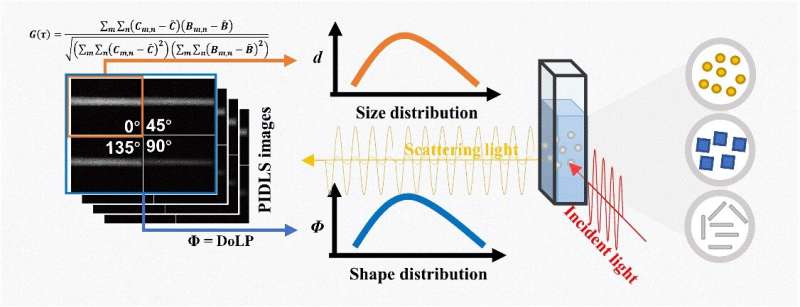This article has been reviewed according to Science X's editorial process and policies. Editors have highlighted the following attributes while ensuring the content's credibility:
fact-checked
proofread
Polarized imaging of dynamic light scattering to measure nanoparticle size, morphology, and distributions

A team of researchers proposed a fast and convenient method called polarized imaging dynamic light scattering (PIDLS) that quantitively evaluates nanoparticle size, morphology and distribution at the same time. A dimensionless quantity, named optical sphericity, is proposed to describe the degree of deviation of nanoparticles from spheres. This method will greatly contribute to in-situ synthesis, structure-function analysis, and quality assessment of nanoparticles.
The team of Chinese researchers from the University of Shanghai for Science and Technology and Jiaxing MeaParTech Instrument Technology Co., Ltd published their work in the journal Particuology.
The performance of nanoparticles is frequently influenced by factors like particle size and shape. Traditionally, electron microscopy or atomic force microscopy is employed for nanoparticle size and morphology analysis. Nonetheless, this approach poses challenges such as complex sample preparation, time-consuming processing, and difficulties in achieving quantitative characterization. A fast, accurate, and statistically meaningful method to measure the size and morphology of nanoparticles will facilitate the related industry.
Unlike electron microscopy and atomic force microscopy methods, the PIDLS method does not directly measure the nanoparticle size and morphology. In fact, PIDLS can be seen as a combination of the imaging dynamic light scattering (IDLS) method and polarized light scattering (PLS) method.
By illuminating a sample of nanoparticles with a polarized laser beam, a polarized camera receives the scattered light and obtains scattering images in the 0°, 45°, 90°, and 135° polarization directions. Due to the continuous random Brownian motion of the particles, the spatial positions and orientations of the particles constantly vary, resulting in fluctuations in the intensity and polarization state of the scattered light.
According to the Stokes-Einstein equation, the rate of intensity fluctuations in the scattered light is related to the particle size, and according to the light scattering theory, the polarization state of the scattered light is related to the particle morphology. By calculating the spatial correlation of two consecutive scattering images in the 0° polarization direction, the rate of intensity fluctuations in the scattered light can be determined, and thus the particle size can be determined.
Continuous measurements can provide multiple particle size measurement results, including the average value and the polydispersity index. By analyzing the intensity of scattered light from four polarization images in 0°, 45°, 90°, and 135° polarization directions taken at the same time, the degree of linear polarization (referred to as optical sphericity in this paper) can be obtained, which can be used to evaluate the degree of approximation of particles to a sphere.
A value of 1 indicates a perfect sphere, while the smaller value indicates the more deviation from a sphere. Continuous measurements can provide the optical sphericity of the nanoparticles, thus obtaining statistical morphological distribution.
In this study, measurements were conducted on spherical, octahedral, flat, rod-shaped, and filamentous nanoparticles. The results of particle size, morphology, and distributions obtained from the PIDLS method were consistent with those obtained from electron microscopy, demonstrating the effectiveness of the proposed method.
The study also measured five industrial-grade titanium dioxide powders and successfully identified the samples with significantly larger particle sizes, lower optical sphericity, and poor consistency in both size and morphology. This highlights the potential application of the PIDLS method in quality control of nano powders.
"This study provides a new tool for evaluating the morphology of nanoparticles," said Xiaoshu Cai, a professor at University of Shanghai for Science and Technology. The PIDLS method can be performed at room temperature and atmospheric pressure in a liquid-phase environment with barely any sample preparation. With its simplicity and fast measurement speed, the PIDLS method holds great potential for widespread application in nanomaterial synthesis in laboratories, nano powder manufacture in plants, and many other cutting-edge fields.
"In the next step, our research team will further validate the universality of the optical sphericity. Additionally, we plan to further investigate the relationship between particle morphology and far-field scattering patterns based on polarization scattering theory, aiming to achieve the classification of particle morphology," said Cai.
In this way, the researchers might expand the application scenarios of PIDLS and improve the potential for practical applications. "Our research group consistently focus on multi-parameter measurement and online measurement of particles, and continuously develop new measurement methods and devices," said Cai.
More information: Bingyao Wang et al, Polarized imaging dynamic light scattering for simultaneous measurement of nanoparticle size and morphology, Particuology (2023). DOI: 10.1016/j.partic.2023.06.004
Provided by Particuology





















